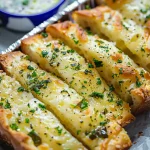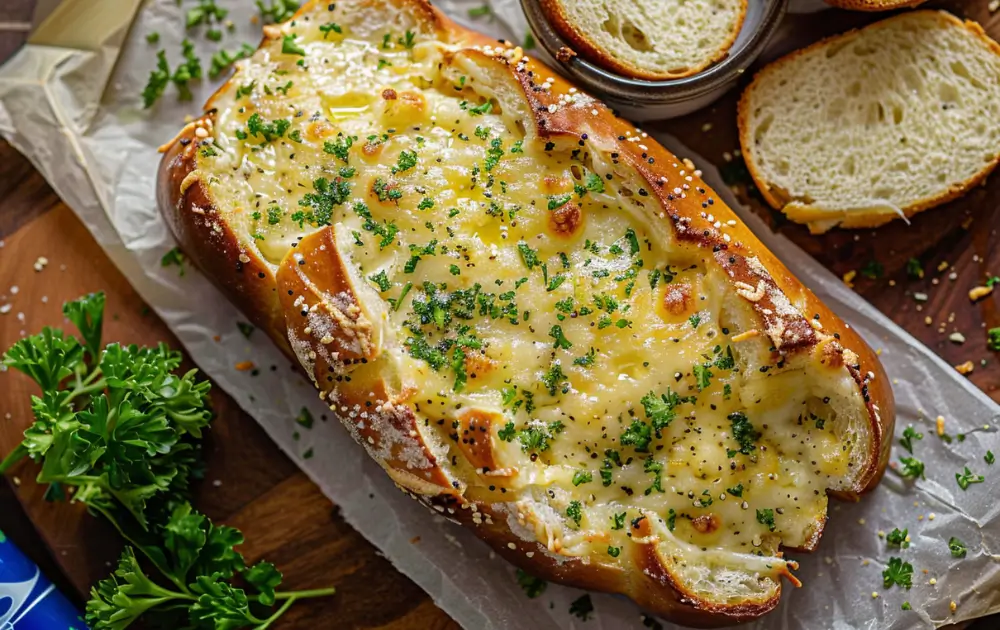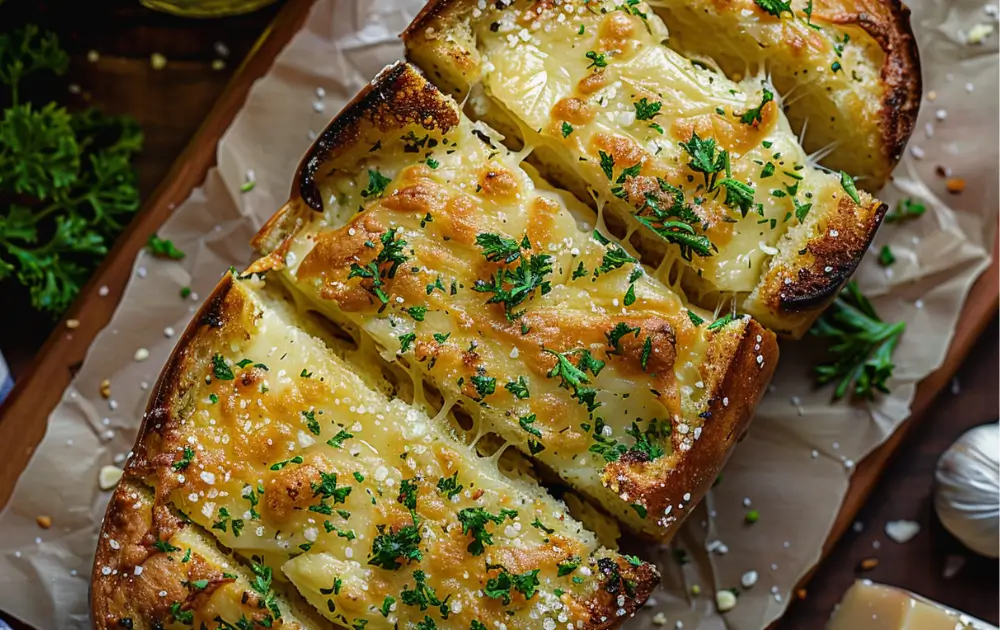Introduction to Easy Garlic Bread
Garlic Bread is a beloved side dish that combines the crispness of toasted bread with the rich flavors of garlic and melted cheese. Ideal for pairing with pasta, soup, or enjoying on its own, this garlic bread recipe uses a loaf of French or Italian bread as a base, which is then slathered with a buttery garlic mixture, sprinkled with cheeses, and baked to golden perfection. The combination of garlic, parsley, and two types of cheese creates a deliciously aromatic and flavorful experience that’s sure to be a hit at any dining table.
Selecting the Right Bread
The choice of bread is crucial for creating the perfect garlic bread. A loaf of French bread or Italian bread works best due to its firm crust and soft interior, which provides the ideal texture when toasted. Look for a loaf that is fresh and has a good crusty exterior. The size of the loaf should be large enough to serve everyone at your table. Before adding any toppings, slice the bread in half lengthwise to maximize the surface area for the garlic butter and cheeses.
Preparing the Garlic Butter Spread
To make the garlic butter spread, start with high-quality unsalted butter, allowing it to soften to room temperature to ensure easy mixing. Combine the softened butter with finely minced garlic cloves, garlic powder, and a pinch of salt for an enhanced garlic flavor. The addition of finely chopped fresh parsley not only introduces a fresh, herbal note but also adds a vibrant color to the spread. Mix these ingredients thoroughly until you achieve a smooth, spreadable consistency.
Adding Cheese for Extra Flavor
Cheese adds a delightful richness and depth to garlic bread. For this recipe, a combination of shredded parmesan and mozzarella cheese is ideal. Parmesan brings a salty, nutty flavor, while mozzarella offers a wonderful meltiness that is essential for perfect garlic bread. Evenly sprinkle the cheeses over the buttered bread to ensure every bite is cheesy and flavorful. The cheeses not only add taste but also help the bread achieve a beautifully golden and bubbly top layer when baked.
Baking to Perfection
Baking is the final step to achieving the ultimate Garlic Bread. Preheat your oven to a high temperature—around 400 degrees Fahrenheit—to ensure the bread toasts nicely without becoming too hard or drying out. Place the buttered and cheese-topped bread halves on a baking sheet and bake in the preheated oven until the cheese is melted and the edges of the bread are crisp and golden brown. This usually takes about 10 to 15 minutes. For those who enjoy a crunchier texture, broil the bread for an additional 1-2 minutes, watching closely to avoid burning.
Serving and Presentation Tips
Presentation can greatly enhance the enjoyment of Garlic Bread. Once baked, let the bread cool slightly before cutting into individual slices. This brief resting period allows the cheese to set slightly, making it easier to cut and serve without losing too much of the topping. Serve the garlic bread on a rustic wooden board or a warm plate to add to the cozy, homemade feel. Garnishing with extra chopped parsley can brighten up the presentation and add a fresh contrast to the rich, golden-brown crust. For a more elegant presentation, consider drizzling a little olive oil over the slices and adding a light sprinkle of red pepper flakes for a bit of heat.
Creative Variations
Experimenting with different ingredients can give a new twist to traditional garlic bread. Try adding a layer of pesto underneath the garlic butter for a touch of basil and pine nut flavors, or incorporate sun-dried tomatoes into the butter mixture for a tangy sweetness. For a heartier version, top the garlic bread with slices of cooked Italian sausage or pepperoni before adding the cheese. Another delicious variation is to use blue cheese or smoked gouda instead of mozzarella for a deeper flavor profile. These creative variations can cater to different taste preferences and make the dish even more versatile.
Pairing with Meals
Garlic Bread pairs wonderfully with a variety of main dishes. It is a classic accompaniment to pasta dishes, especially those with rich tomato or cream-based sauces. The crisp, savory bread complements the soft textures and flavors of pasta perfectly. Garlic bread is also a great side for soup, particularly creamy soups or hearty stews, as it provides a satisfying crunch. During a barbecue or informal gathering, serve garlic bread as an appetizer or alongside grilled meats and vegetables. The versatility of garlic bread makes it a welcome addition to nearly any meal.
Storing and Reheating
If you find yourself with leftover garlic bread, it can be stored and reheated while still maintaining its delicious taste. Wrap the bread in aluminum foil and store it in the refrigerator for up to two days. To reheat, place the wrapped bread in an oven preheated to 350 degrees Fahrenheit for about 10-15 minutes, or until it’s thoroughly warmed and the cheese is bubbly again. Avoid microwaving as it can make the bread soggy. Properly storing and reheating garlic bread ensures that it remains a delightful treat even the next day.
Healthier Options
For those looking to enjoy garlic bread with a healthier twist, there are several adjustments that can be made. Opt for whole grain or whole wheat bread as a base to increase fiber content. Use light butter or a heart-healthy olive oil spread instead of regular butter, and choose low-fat cheese options. Adding more herbs like basil, oregano, or thyme can enhance the flavor without extra calories. These substitutions help make garlic bread a more nutritious option without sacrificing the delicious flavors that make it so enjoyable.
Enhancing the Flavor with Additional Toppings
To further enhance the flavor of Garlic Bread, consider incorporating additional toppings before baking. Adding a layer of caramelized onions or roasted garlic can introduce a sweet, mellow contrast to the sharpness of the fresh garlic. Sprinkling capers or olives adds a briny depth that pairs well with the creamy cheese. For a touch of freshness, top the bread with arugula or basil leaves after baking, giving it a peppery or aromatic lift that enhances the overall flavor profile. These extra toppings not only enrich the taste but also add a gourmet twist to this classic side dish.
Hosting with Garlic Bread
Garlic bread is an excellent choice for hosting, as it is widely enjoyed and easy to prepare in large quantities. When planning for parties or family dinners, garlic bread can be made ahead and popped in the oven just before guests arrive, ensuring it is warm and fresh when served. Offering a variety of garlic bread versions, such as one with added spices and another with extra cheeses, can cater to different taste preferences, making it a versatile option for any gathering. Additionally, serving garlic bread as part of a build-your-own pasta station can be a fun and interactive way for guests to customize their meals.
Cooking Tips for Perfect Garlic Bread
Achieving the perfect garlic bread involves a few key cooking tips. First, ensure that the garlic butter is evenly spread across the bread to prevent dry spots. Broiling the bread for the last few minutes of cooking can help achieve a beautifully crisped top without burning it, but keep a close eye as it can brown quickly. If using a softer bread, toast it lightly before adding the toppings to prevent it from becoming soggy. These small but crucial steps help in creating a consistently delicious garlic bread every time.
Incorporating Garlic Bread into Different Cuisines
While traditionally served with Italian meals, garlic bread can be adapted to complement a variety of cuisines. For a Mexican twist, add jalapeños and a sprinkle of cotija cheese, or for a Mediterranean version, use feta cheese, sun-dried tomatoes, and a dash of oregano. These adaptations can turn ordinary garlic bread into a culturally inspired side that pairs beautifully with regional dishes, expanding its culinary versatility and appeal in international themed menus.
Learning and Educational Opportunities
Garlic bread offers an excellent learning opportunity for novice cooks, as it involves basic cooking techniques such as mixing, spreading, and baking. Cooking classes focused on making the perfect garlic bread can teach students about the importance of ingredient ratios, seasoning, and cooking times. Additionally, such classes can incorporate lessons on how to pair different types of bread with suitable cheeses and herbs, providing a comprehensive understanding that students can apply to other cooking endeavors.
Sustainable Cooking Practices
Integrating sustainable cooking practices when making Garlic Bread can have a positive impact on the environment. Opting for ingredients that are locally sourced, such as bread from a local bakery and cheese from nearby dairy farms, can reduce the carbon footprint associated with transportation. Using organic garlic and herbs can support sustainable agriculture that minimizes pesticide use. Additionally, cooking in bulk to save energy and utilizing the entire loaf to avoid food waste are practices that enhance sustainability. These steps not only promote a healthier planet but also ensure that the ingredients are as fresh and flavorful as possible.
Dietary Customizations
Garlic Bread can be customized to fit various dietary restrictions, making it accessible to a wider audience. For gluten-free options, substitute regular bread with a gluten-free variety. Those with lactose intolerance can enjoy the dish by replacing traditional cheese with lactose-free or vegan cheese. Adding nutritional yeast instead of parmesan can cater to vegan diets while still providing a cheesy flavor. By making these adjustments, everyone can enjoy garlic bread regardless of dietary limitations, ensuring that no guest feels left out.
Seasonal Variations
To keep Garlic Bread exciting all year round, consider incorporating seasonal ingredients. In the spring, add fresh green garlic or chives for a mild, herby flavor. During summer, top with fresh basil or parsley from the garden to enhance the freshness of the dish. In autumn, adding a sprinkle of roasted pumpkin seeds can introduce a crunchy texture and a nutty flavor, while winter might call for a more indulgent version with extra cheese and aromatic rosemary. These seasonal variations not only keep the dish interesting but also align with what is naturally available throughout the year.
Technological Cooking Advances
Embracing technological advances in cooking can elevate the preparation of Garlic Bread. Modern kitchen gadgets like convection ovens can cook the bread more evenly and quickly, while high-quality food processors make preparing the garlic butter mixture more efficient. For those interested in precision cooking, using a cooking thermometer can ensure the bread is toasted to just the right temperature without burning. By leveraging these technologies, cooks can save time and energy, enhancing the cooking experience and ensuring consistent results every time.
Community Engagement
Using Garlic Bread as a tool for community engagement can be both fun and rewarding. Organizing baking workshops or community cook-offs where participants create their versions of garlic bread can foster a sense of community and shared learning. These events can serve as a platform for home cooks to showcase their culinary skills and for neighbors to bond over delicious food. Additionally, local cafes or community centers can feature a “Garlic Bread Day” where different styles of garlic bread are served, turning a simple dish into a celebration of local culture and cuisine.
Frequently Asked Questions about Garlic Bread
- How do I prevent my garlic bread from becoming too oily? To prevent garlic bread from becoming too oily, measure the butter accurately and ensure it’s evenly distributed over the bread. Using a pastry brush can help spread the butter mixture more evenly.
- Can I make garlic bread ahead of time? Yes, you can prepare garlic bread ahead of time by spreading the garlic mixture on the bread and wrapping it tightly in foil. Refrigerate until ready to bake. This can be done up to a day in advance.
- What’s the best way to reheat garlic bread? Reheat garlic bread in the oven at 350°F for about 10 minutes or until it’s warm and crispy again. Avoid microwaving as it can make the bread soggy.
- Can I freeze garlic bread? Absolutely! Prepare the garlic bread and wrap it in foil. Place it in a freezer bag and freeze. When ready to serve, bake directly from frozen in a 350°F oven until hot and crispy, about 15-20 minutes.
- What are some creative toppings I can add to garlic bread? Besides the traditional toppings, you can add a sprinkle of cooked bacon, a layer of pesto, or even some sliced tomatoes and mozzarella for a caprese-style garlic bread.
Conclusion
Garlic Bread is a versatile and beloved dish that complements a wide variety of meals, from pasta to salads and soups. Its preparation involves simple ingredients and steps, making it accessible for cooks of all skill levels. By following the tips provided, such as proper ingredient measurement and even distribution of the garlic butter, anyone can create delicious, perfectly crispy garlic bread. Additionally, the ability to make it ahead of time and the option to freeze it for future use make garlic bread a convenient choice for both everyday meals and special occasions. Whether you stick to the classic recipe or experiment with creative variations, garlic bread remains a crowd-pleaser that adds a flavorful touch to any dining table.

Easy Garlic Bread
- Total Time: 25 minutes
- Yield: 8
- Diet: Vegetarian
Description
Easy Garlic Bread combines the crispiness of toasted bread with the rich flavor of garlic butter, all topped with melted cheeses. It’s a classic side dish that pairs wonderfully with pasta, soups, and salads or is perfect as a standalone snack.
Ingredients
Instructions
Notes
- For a lighter version, use low-fat cheese and replace butter with a low-calorie butter substitute.
- Add a sprinkle of chili flakes or drizzle with balsamic glaze for an extra flavor kick
- Prep Time: 10 minutes
- Cook Time: 15 minutes
- Category: Side Dish
- Method: Baking
- Cuisine: Italian
Nutrition
- Calories: 250
- Sugar: 1g
- Fat: 15g
- Carbohydrates: 22g
- Fiber: 1g
- Protein: 8g
- Cholesterol: 40mg



